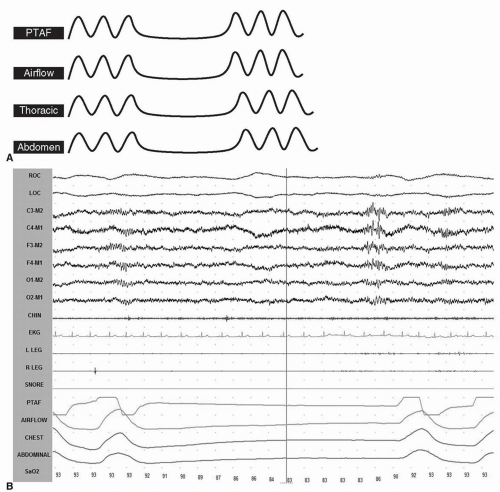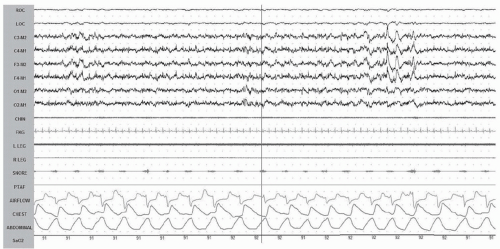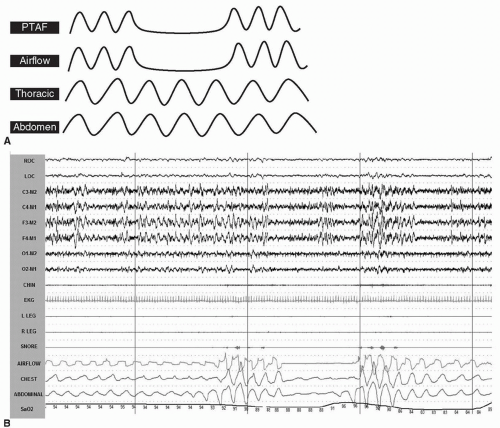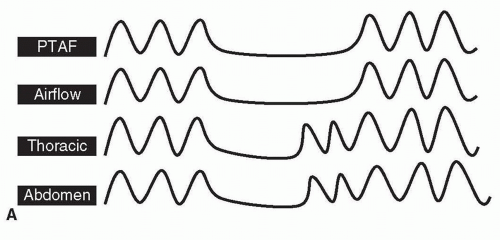Scoring Respiratory Events
Laree J. Fordyce
LEARNING OBJECTIVES
On completion of this chapter, the reader should be able to:
1. Identify sleep-related breathing events according to the American Academy of Sleep Medicine adult respiratory scoring rules.
2. Define the various types of sleep-related breathing events.
3. Identify common artifacts that occur in the respiratory channels.
KEY TERMS
Obstructive apnea
Mixed apnea
Central apnea
Hypopnea
Respiratory artifact
Respiratory event-related arousal (RERA)
Hypoventilation
Scoring respiratory events is an important part of our jobs as sleep technologists. The AASM Manual for the Scoring of Sleep and Associated Events has outlined the respiratory scoring rules for both adults and pediatrics. In this chapter, we review the respiratory scoring rules in adults as well as show examples to illustrate respiratory events and how these events should be scored.
The current Parameters to Be Recorded as well as the Technical Specifications for Respiratory Rules for both adults and pediatrics are outlined in the AASM Manual for the Scoring of Sleep and Associated Events and should be reviewed to ensure collection of data meets these standards (1).
When scoring respiratory events, it is important to record the proper signals using the appropriate sensors (1). We should be recording airflow using an oronasal thermal sensor (this includes thermistors, thermocouples, or polyvinylidene fluoride airflow sensors) or a nasal pressure transducer. For respiratory effort channels, thoracic and abdominal respiratory inductance plethysmography (RIP) belts are recommended. The RIPsum and RIPflow channels can be a helpful tool for scoring respiratory events. See Figure 39-1 for an example of a normal respiratory pattern.
APNEA
An apnea should be scored using the oronasal thermal airflow sensor; however, alternatives such as a nasal transducer, RIPsum, or RIPflow may be used if this sensor is not functioning. When performing a positive airway pressure (PAP) titration study, use the PAP device flow signal to score apneas. There are three types of apneas: obstructive, central, and mixed.
Obstructive Apnea
An obstructive apnea (see Fig. 39-2A, B) is defined as cessation of airflow (drop in signal by ≥90% of the preevent baseline using an oronasal thermal airflow sensor) with continued respiratory effort throughout the event.
The duration of the event is greater than or equal to 10 seconds.
Central Apnea
A central apnea (see Fig. 39-3A, B) is defined as cessation of airflow (drop in signal by ≥90% of the preevent baseline using an oronasal thermal airflow sensor) with absent respiratory effort throughout the entire event.
The duration of the event is greater than or equal to 10 seconds.
Mixed Apnea
A mixed apnea (see Fig. 39-4A, B) is defined as cessation of airflow (drop in signal by ≥90% of the preevent baseline using an oronasal thermal airflow sensor) for at least 10 seconds, with resumption of respiratory effort in the second part of the event.
The duration of the event is greater than or equal to 10 seconds.
 Figure 39-3 A, B: Central apnea. In this example, the airflow as well as the respiratory effort is completely absent. PTAF, pressure transducer airflow. |
 Figure 39-4 (Continued)
Stay updated, free articles. Join our Telegram channel
Full access? Get Clinical Tree
 Get Clinical Tree app for offline access
Get Clinical Tree app for offline access

|






